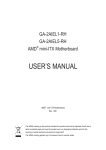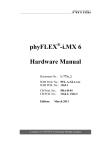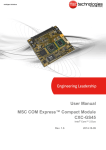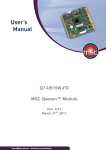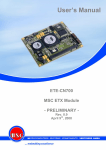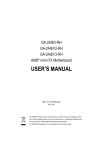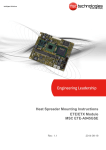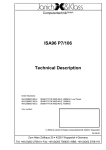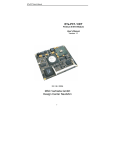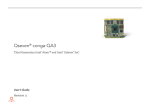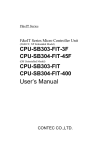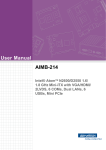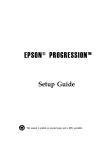Download User Manual ETE/ETX Module MSC ETE-A945GSE-1
Transcript
User Manual ETE/ETX Module MSC ETE-A945GSE-1 Intel® AtomTM N270 Rev. 0.2 2014-09-19 MSC ETE-A945GSE-1 - PRELIMINARY - User Manual Preface Copyright Notice Copyright © 2014 MSC Technologies GmbH. All rights reserved. Copying of this document, and giving it to others and the use or communication of the contents thereof, is forbidden without express authority. Offenders are liable to the payment of damages. All rights are reserved in the event of the grant of a patent or the registration of a utility model or design. Important Information This documentation is intended for qualified audience only. The product described herein is not an end user product. It was developed and manufactured for further processing by trained personnel. Disclaimer Although this document has been generated with the utmost care no warranty or liability for correctness or suitability for any particular purpose is implied. The information in this document is provided “as is” and is subject to change without notice. EMC Rules This unit has to be installed in a shielded housing. If not installed in a properly shielded enclosure, and used in accordance with the instruction manual, this product may cause radio interference in which case the user may be required to take adequate measures at his or her owns expense. Trademarks All used product names, logos or trademarks are property of their respective owners. Certification MSC Technologies GmbH is certified according to DIN EN ISO 9001:2000 standards. Life-Cycle-Management MSC products are developed and manufactured according to high quality standards. Our lifecycle-management assures long term availability through permanent product maintenance. Technically necessary changes and improvements are introduced if applicable. A productchange-notification and end-of-life management process assures early information of our customers. Product Support MSC engineers and technicians are committed to provide support to our customers whenever needed. Before contacting Technical Support of MSC Technologies GmbH, please consult the respective pages on our web site at www.msc-technologies.eu/support/boards for the latest documentation, drivers and software downloads. If the information provided there does not solve your problem, please contact our Technical Support: Email: [email protected] Phone: +49 8165 906-200 2 / 55 MSC ETE-A945GSE-1 - PRELIMINARY - User Manual Content 1 2 3 4 5 6 General Information ......................................................................................................................... 4 1.1 Revision History ........................................................................................................................ 4 1.2 Introduction ............................................................................................................................... 4 Technical Description ....................................................................................................................... 5 2.1 Specifications............................................................................................................................ 5 2.2 Block diagram ........................................................................................................................... 7 2.3 Installation ................................................................................................................................ 7 2.3.1 Jumpers and switches ........................................................................................................ 7 2.3.2 Installing a DDR2 SO-DIMM module .................................................................................. 7 2.4 Watchdog ................................................................................................................................. 8 2.5 Interrupts, DMA channels, Upper memory ................................................................................. 8 2.5.1 PCI Devices ....................................................................................................................... 8 2.5.2 DMA channels.................................................................................................................... 9 2.5.3 Memory map ...................................................................................................................... 9 2.5.4 SMBus address map .......................................................................................................... 9 Mechanical Specification .................................................................................................................10 3.1 Top view ..................................................................................................................................10 3.2 Bottom view .............................................................................................................................10 ETX Connectors..............................................................................................................................11 4.1 Connector X1 (PCI, USB, Audio) ..............................................................................................11 4.2 Connector X2 (ISA) ..................................................................................................................13 4.3 Connector X3 (CRT, Display, TVout, Serial, Parallel, Mouse, Keyboard) .................................15 4.4 Connector X3 - alternate pinout ................................................................................................19 4.5 Connector X4 ...........................................................................................................................20 (EIDE, Ethernet, Speaker, Batterie, I2C, SMBus, etc.) ........................................................................20 4.6 Connector X5 (FAN).................................................................................................................22 4.7 SATA Connectors ....................................................................................................................22 4.8 Mini USB Connectors ...............................................................................................................23 4.9 LVDS Connector X9 (option) ....................................................................................................23 BIOS...............................................................................................................................................24 5.1 Introduction ..............................................................................................................................24 5.1.1 Startup Screen Overview...................................................................................................24 5.1.2 Activity Detection Background ...........................................................................................24 5.2 TrustedCore Setup Utility .........................................................................................................25 5.2.1 Configuring the System BIOS ............................................................................................25 5.2.2 The Main Menu .................................................................................................................27 5.2.3 The Advanced Menu .........................................................................................................31 5.2.4 The Security Menu ............................................................................................................41 5.2.5 The Power Menu ...............................................................................................................42 5.2.6 The Boot Menu .................................................................................................................43 5.2.7 The Exit Menu ...................................................................................................................44 5.3 Bios Update .............................................................................................................................45 5.4 Bios Crisis Recovery ................................................................................................................46 5.5 Diagnostics Postcodes .............................................................................................................48 5.5.1 Bootblock Bios Postcodes .................................................................................................48 5.5.2 System Bios Postcodes .....................................................................................................49 5.5.3 Memory Detection Postcodes ............................................................................................53 5.5.4 ACPI Postcodes ................................................................................................................54 Troubleshooting ..............................................................................................................................55 3 / 55 MSC ETE-A945GSE-1 User Manual - PRELIMINARY - 1 General Information 1.1 Revision History Rev. 0.1 0.2 Date 2012-11-28 2014-09-19 Description Draft New covering page 1.2 Introduction The ETe-A945GSE is an all-in-one AtomTM N270 CPU module. It is fully compliant with the ETX 3.0 standard. The module is based on Intel AtomTM N270 CPU and the Intel 945GSE chipset. The Intel AtomTM N270 CPU is on the embedded roadmap of Intel , which means that the processors are long term available. The Intel AtomTM N270 CPU supports 533MHz CPU bus. The Intel 945GSE supports 400/533MHz memory bus. The ETE- A945GSE supports DDR2 memory modules. It provides a 200-pin SO-DIMM socket giving you the flexibility to configure your system up to 2GB of DDR2-DRAM. The integrated 32-bit 3D Intel Graphics Media Accelerator 950 supports a dual-channel LVDS graphic interface. On board features include a 10/100Base-T RTL8103T Ethernet controller, two EIDE ports, audio, parallel / floppy, serial, keyboard and mouse interfaces, six USB2.0 ports and two SATA ports. 4 / 55 MSC ETE-A945GSE-1 - PRELIMINARY - User Manual 2 Technical Description 2.1 Specifications Core CPU Intel® Atom TM Processor N270, 1.60GHz, 533 MHz, FCBGA8, soldered. ChipSet Mobile Intel ® 945GSE Intel ® 82801GBM ICH7-M L2 Cache 512KB 1.60GHz 533 MHz Memory 200-Pin SO-DIMM socket for DDR2 (max. 2GByte) ISA-Bus Interface PCI to ISA Bridge ITE8888 (ETX connector X2) PCI-Bus Interface Intel ® 82801 ICH7 (ETX connector X1) Video Intel® Gen 3.5 Integrated Graphics Engine CRT-Interface (Optional Flat Panel Interface (LVDS 18bit single-/dualchannel)) Chrontel® CH7308 SDVO to LVDS converter (LVDS 24bit single-/dual-channel) Ethernet LAN controller RTL8103T (10/100Base-T) Audio HDA decoder VT1708s USB integrated in Intel ® 82801GBM ICH7-M: 6 USB 1.1/2.0 ports EIDE integrated in Intel ® 82801GBM ICH7-M: 1 Port for up to 2 devices Ultra ATA/66/100 JMICRON® JMB368 PCIe to PATA controller: 1 Port for up to 2 devices Ultra ATA/66/100 Floppy Disk integrated in W83627 SIO (pins shared with parallel port) SATA integrated in Intel ® 82801GBM ICH7-M: 2 Ports Serial, COM1, COM2 integrated in W83627 SIO: 2 x TTL IrDA on COM2 Parallel integrated in W83627 SIO: 1 Parallel Port (PS/2-compatible/ECP/EPP via SETUP configurable, pins shared with floppy port) 5 / 55 MSC ETE-A945GSE-1 User Manual - PRELIMINARY - Keyboard, Mouse integrated in W83627 SIO: MFII-Keyboard Interface, PS/2-Mouse Interface Realtime Clock integrated in 82801GBM ICH7-M (external battery required) Watchdog Microcontroller PIC12F509A: Start delay and timeout configurable via SETUP creates hardware reset TPM (optional) Trusted Plattform Module TPM 1.2: SLB 9635 TT 1.2 EDID-EEPROM on Board EDID EEPROM: enable / disable via SETUP BIOS Phoenix Trusted/SecureCore in SPI Flash device EEPROM EEPROM for CMOS Setup backup System Monitoring 1 fan with speed input (valid only if optional fan connector is used) 3 temperatures (CPU, GSE and board: EMC2104) 6 voltages (Vcore(CPU), +2.5V, +3.3V, +1.5V, +1.05V, Vbat: W83627 SIO) Power supply +5V ±5% Typical supply current (DOS prompt) 1.6 A Typical CMOS battery power consumption 1.8 µA Environment Temperature RTC / CMOS integrated in Intel 82801GBM ICH7-M 0 ... + 60°C (operating), -25 ... + 85°C (non operating) Humidity (rel.) 0 … 95 % (operating), 5 … 95 % (non operating) Note: A heat spreader plate is available from MSC providing a standard thermal interface for the module. The heat spreader is not a heat sink! Dimensions 95 x 114 x 12 mm 6 / 55 MSC ETE-A945GSE-1 User Manual - PRELIMINARY - 2.2 Block diagram Power IN +5V +5V Standby VBAT Power +3,30V +2,50V +1,80V +1,50V +1,35V +1,25V +1,05V +0,90V VCCCORE +3,3VSUS +1,5VSUS CPU Intel® Atom® N270 BGA CRT Northbridge X3 PC5300 DDR2 SDRAM SODIMM max. 2GByte Intel® 945GSE LVDS 2x24Bit X3 LVDS 2x18Bit X9 Clock ICS9LPR3 65 2x mini USB X10/X11 SPI Flash MSC ETE-A945GSE-1 SM B FAN X5 HW-Monitor EMC2104 SPI Southbridge Intel® ICH7M LP C TPM 1.2 Infineon® EEPROM Super I/O Winbond® W83627HF I/O PS2, Floppy, LPT, COM1/2, IRDA, X3 PCI X1 PCI PCI / ISA ITE8888 Watch dog PCIe PCIe to PATA JMB368 USB USB 1-4 X1 EIDE 2x IDE X4 Audio codec VT1708s SM B RTL 8103T Audio SMBus SATA LAN X1 X4 X7 X8 X1 ISA 2.3 Installation 2.3.1 Jumpers and switches There are no jumpers or switches. 2.3.2 Installing a DDR2 SO-DIMM module The ETE-A945GSE board has a standard 200-pin SO-DIMM socket for 1.8V DDR2SDRAM SO-DIMM modules. The chipset supports 256-Mbit, 512-Mbit and 1-Gbit technologies providing maximum capacity of 2GB. Note: Module height should not exceed 1260 mil (= 32 mm) 7 / 55 ISA X2 MSC ETE-A945GSE-1 User Manual - PRELIMINARY - 2.4 Watchdog The ETE- A945GSE board has a watchdog function implemented in a PIC Microcontroller. Via SETUP the watchdog can be enabled and configured. If the watchdog is enabled a counter is started which creates a reset if it is not retriggered within a programmable time window. Possible watchdog delays: Disabled (default), 1s, 5s, 10s, 1min, 5min, 10min The time delay starts before the OS is loaded. To retrigger the watchdog use the uebi.exe tool. 2.5 Interrupts, DMA channels, Upper memory IRQ used for available comment 0 Timer 0 No 1 Keyboard No 2 Slave 8259 No 3 COM2 / COM1 No (1) 4 COM1 / COM2 No (1) 5 LPT2 / LPT1 Yes (1) / (2) 6 Floppy Disk Controller No (1) 7 LPT1 / LPT2 No (1) / (2) 8 Real Time Clock No 9 PCI Yes (1) 10 PCI / COM3 Yes (1) / (2) 11 PCI / COM4 Yes (1) / (2) 12 PS/2 Mouse No (1) 13 Floating Point Unit No 14 Primary IDE No (1) 15 Secondary IDE No (1) (1) If the device is disabled in SETUP, the interrupt is available. (2) Can be used by external Super I/O controller FDC37C669 2.5.1 PCI Devices PCI Device PCI to ISA ITE8888 Sound (MODEM, not used) USB 0..3 (Southbridge) PCI Interrupt REQ/GNT (0..3) IDSEL serial 4/45/5 AD29 INTA / INTB --- INTC --- 8 / 55 MSC ETE-A945GSE-1 User Manual - PRELIMINARY - 2.5.2 DMA channels DMA used for available 0 comment Yes 1 (ECP, if enabled) (No) 2 Floppy Disk Controller No 3 (ECP, if enabled) (No) 4 Cascade No 5..7 --- Yes LPT ECP mode, if enabled LPT ECP mode (default) 2.5.3 Memory map Upper Memory used for available comment C0000h..CFFFFh VGA BIOS No 64 KB VGA BIOS D0000h..D3FFFh SATA Yes/No Shared with SATA OPROM*) Yes ISA bus or shadow RAM D4000h..DFFFFh E0000h..E3FFFh USB Buffer No E4000h..FFFFFh System BIOS *) free when SATA OPROM disabled No 2.5.4 SMBus address map Device A6 A5 A4 A3 A2 A1 A0 R/W address *) SMBus host 0 0 0 1 0 0 0 x 10h clock synthesizer IC9LPRS365 1 1 0 1 0 0 1 x D2h watchdog 1 0 1 1 0 0 0 x B0h HW monitor EMC2104 0 1 0 1 1 1 1 x 5Eh SIO W83627HF (default) 0 0 1 0 1 1 0 x 5Ah SIO W83627HF Temp3 default 1 0 0 1 0 0 0 x 90h SIO W83627HF Temp2 default 1 0 0 1 0 0 1 x 92h CMOS backup EEPROM #1 1 0 1 0 1 0 0 x A8h CMOS backup EEPROM #2 1 0 1 0 1 0 1 x AAh SPD EEPROM (SO-DIMM) 1 0 1 0 0 0 0 x A0h *) 8 bit address (with R/W) / 7 bit address (without R/W) 9 / 55 MSC ETE-A945GSE-1 - PRELIMINARY - User Manual 3 Mechanical Specification 3.1 Top view X10 X11 X8 X2 X4 X7 X3 X1 X5 X9 3.2 Bottom view X2 X4 X3 X3 10 / 55 MSC ETE-A945GSE-1 User Manual - PRELIMINARY - 4 ETX Connectors 4.1 Connector X1 (PCI, USB, Audio) Pin Signal Pin Signal Pin Signal Pin Signal 1 GND 2 GND 51 VCC 52 VCC 3 PCICLK3 4 PCICLK4 53 PAR 54 SERR# 5 GND 6 GND 55 GPERR# 56 RESERVED 7 PCICLK1 8 PCICLK2 57 PME# 58 USB2# 9 REQ3# 10 GNT3# 59 LOCK# 60 DEVSEL# 11 GNT2# 12 3.3V 61 TRDY# 62 USB3# 13 REQ2# 14 GNT1# 63 IRDY# 64 STOP# 15 REQ1# 16 3.3V 65 FRAME# 66 USB2 17 GNT0# 18 RESERVED 67 GND 68 GND 19 VCC 20 VCC 69 AD16 70 CBE2# 21 SERIRQ 22 REQ0# 71 AD17 72 USB3 23 AD0 24 3.3V 73 AD19 74 AD18 25 AD1 26 AD2 75 AD20 76 USB0# 27 AD4 28 AD3 77 AD22 78 AD21 29 AD6 30 AD5 79 AD23 80 USB1# 31 CBE0# 32 AD7 81 AD24 82 CBE3# 33 AD8 34 AD9 83 VCC 84 VCC 35 GND 36 GND 85 AD25 86 AD26 37 AD10 38 AUXAL 87 AD28 88 USB0 39 AD11 40 MIC 89 AD27 90 AD29 41 AD12 42 AUXAR 91 AD30 92 USB1 43 AD13 44 ASVCC 93 PCIRST# 94 AD31 45 AD14 46 SNDL 95 INTC# 96 INTD# 47 AD15 48 ASGND 97 INTA# 98 INTB# 49 CBE1# 50 SNDR 99 GND 100 GND 11 / 55 MSC ETE-A945GSE-1 Signal VCC GND 3V RESERVED Signal User Manual - PRELIMINARY - Description Power Supply +5V, +/-5% Power Ground Power Supply +3.3V Not connected I/O I I O n.a. Note external supply external supply Do not use externally Do not connect Description of PCI Bus Signals I/O Note PCI outputs 3,3V signal level PCI inputs 5V tolerant PCICLK1..4. REQ0..3# GNT0..3# AD0..31 CBE0..3# PAR SERR# GPERR# PME# LOCK# DEVSEL# TRDY# IRDY# STOP# FRAME# PCIRST# INTA# INTB# INTC# INTD# SERIRQ Signal USB0, USB0# USB1, USB1# USB2, USB2# USB3, USB3# USB4, USB4# USB5, USB5# Signal SNDL SNDR AUXAL AUXAR MIC ASGND ASVCC PCI clock output PCI bus request PCI bus grant PCI Adress-/ Databus PCI bus command/byte enables PCI bus parity PCI bus system error PCI bus grant parity error PCI bus power management event PCI bus lock PCI bus device select PCI bus target ready PCI bus initiator ready PCI bus stop PCI bus frame PCI bus reset PCI bus interrupt A PCI bus interrupt B PCI bus interrupt C PCI bus interrupt D Serial interrupt request Description of USB Signals USB Port 0 USB Port 1 USB Port 2 USB Port 3 USB Port 4 USB Port 5 Description of Audio Signals Line-Level stereo output left Line-Level stereo output right Auxiliary input A left Auxiliary input A right Microphone input Analog ground of sound controller Analog supply of sound controller 12 / 55 O I O I/O I/O I/O I/O I/O I/O I/O I/O I/O I/O I/O I/O O I I I I I/O I/O I/O I/O I/O I/O I/O I/O PU 8k2 3,3V PU 8k2 3,3V PU 8k2 3,3V internal PU 20k 3,3Vsus PU 8k2 3,3V PU 8k2 3,3V PU 8k2 3,3V PU 8k2 3,3V PU 8k2 3,3V PU 8k2 3,3V 3,3V signal level PU 8k2 3,3V PU 8k2 3,3V PU 8k2 3,3V PU 8k2 3,3V PU 10k 3,3V Note 5V tolerant; internal PD 15k 5V tolerant; internal PD 15k 5V tolerant; internal PD 15k 5V tolerant; internal PD 15k 5V tolerant; internal PD 15k 5V tolerant; internal PD 15k I/O O O I I I I O Note 0.7VRMS 0.7VRMS 3.3V MSC ETE-A945GSE-1 User Manual - PRELIMINARY - 4.2 Connector X2 (ISA) Pin Signal Pin Signal Pin Signal Pin Signal 1 GND 2 GND 51 VCC 52 VCC 3 SD14 4 SD15 53 SA6 54 IRQ5 5 SD13 6 MASTER# 55 SA7 56 IRQ6 7 SD12 8 DREQ7 57 SA8 58 IRQ7 9 SD11 10 DACK7# 59 SA9 60 SYSCLK 11 SD10 12 DREQ6 61 SA10 62 REFSH# 13 SD9 14 DACK6# 63 SA11 64 DREQ1 15 SD8 16 DREQ5 65 SA12 66 DACK1# 17 MEMW# 18 DACK5# 67 GND 68 GND 19 MEMR# 20 DREQ0 69 SA13 70 DREQ3 21 LA17 22 DACK0# 71 SA14 72 DACK3# 23 LA18 24 IRQ14 73 SA15 74 IOR# 25 LA19 26 IRQ15 75 SA16 76 IOW# 27 LA20 28 IRQ12 77 SA18 78 SA17 29 LA21 30 IRQ11 79 SA19 80 SMEMR# 31 LA22 32 IRQ10 81 IOCHRDY 82 AEN 33 LA23 34 IO16# 83 VCC 84 VCC 35 GND 36 GND 85 SD0 86 SMEMW# 37 SBHE# 38 M16# 87 SD2 88 SD1 39 SA0 40 OSC 89 SD3 90 NOWS# 41 SA1 42 BALE 91 DREQ2 92 SD4 43 SA2 44 TC 93 SD5 94 IRQ9 45 SA3 46 DACK2# 95 SD6 96 SD7 47 SA4 48 IRQ3 97 IOCHK# 98 RSTDRV 49 SA5 50 IRQ4 99 GND 100 GND 13 / 55 MSC ETE-A945GSE-1 Signal VCC GND Signal SD0..15 User Manual - PRELIMINARY - Description Power Supply +5V, +/-5% Power Ground I/O I I Note external supply external supply ISA Bus Signals ISA Databus I/O I/O I/O I/O I/O I/O I/O I/O I/O Note all ISA outputs 5V signal level (PU 8k2 5V) all ISA inputs 5V tolerant PU 8k2 5V PU 8k2 5V internal PU 50k 5V PD 4k7 PD 4k7 PU 8k2 5V PU 1k0 5V I/O I/O PU 8k2 5V PU 1k0 5V I/O I/O I I/O I/O I I/O PU 8k2 5V PU 8k2 5V PU 4k7 5V PU 1k0 5V PU 1k0 5V PU 1k0 5V PU 1k0 5V I I O O O I I/O I/O I I I/O I PU 1k0 5V PU 1k0 5V SA0..19 LA17..23 SBHE# BALE AEN MEMR# SMEMR# ISA Addressbus ISA Addressbus ISA Byte High Enable ISA Address Latch Enable ISA Address Enable ISA memory read ISA memory read in lowest 1MB address range MEMW# ISA memory write SMEMW# ISA memory write in lowest 1MB address range IOR# ISA IO read IOW# ISA IO write IOCHK# ISA IO check IOCHRDY ISA IO channel ready M16# ISA 16Bit memory device IO16# ISA 16Bit IO device REFSH# ISA memory refresh cycle pending NOWS# ISA No waitstates MASTER# ISA Master SYSCLK ISA System clock (8 MHz) OSC ISA Oscillator (14,31818 MHz) RSTDRV ISA Reset signal DREQ0..7 ISA DMA request DACK0#..7# ISA DMA acknowledge TC ISA DMA end IRQ3..7 ISA Interrupt request IRQ9..12 ISA Interrupt request IRQ14 ISA Interrupt request IRQ15 ISA Interrupt request 14 / 55 PD 8k2 PD 4k7 IRQ table see 2.5; PU 8k2 5V IRQ table see 2.5; PU 8k2 5V IRQ table see 2.5; PU 8k2 5V IRQ table see 2.5; PU 8k2 5V MSC ETE-A945GSE-1 User Manual - PRELIMINARY - 4.3 Connector X3 (CRT, Display, TVout, Serial, Parallel, Mouse, Keyboard) Standard pinout with LVDS and LPT Pin Signal Pin Signal Pin Signal Pin Signal 1 GND 2 GND 51 LPT/FLPY# 52 RESERVED 3 R 4 B 53 VCC 54 GND 5 HSY 6 G 55 STB#/RES 56 AFD#/DENSEL 7 VSY 8 DDCK 57 RESERVED 58 PD7/RES 9 DETECT# 10 DDDA 59 IRRX 60 ERR#/HDSEL# 11 LCDDO16 12 LCDDO18 61 IRTX 62 PD6/RES 13 LCDDO17 14 LCDDO19 63 RXD2 64 INIT#/DIR# 15 GND 16 GND 65 GND 66 GND 17 LCDDO13 18 LCDDO15 67 RTS2# 68 PD5/RES 19 LCDDO12 20 LCDDO14 69 DTR2# 70 SLIN#/STEP# 21 GND 22 GND 71 DCD2# 72 PD4/ DSKCHG# 23 LCDDO8 24 LCDDO11 73 DSR2# 74 PD3/RDATA# 25 LCDDO9 26 LCDDO10 75 CTS2# 76 PD2/WP# 27 GND 28 GND 77 TXD2 78 PD1/TRK0# 29 LCDDO4 30 LCDDO7 79 RI2# 80 PD0/INDEX# 31 LCDDO5 32 LCDDO6 81 VCC 82 VCC 33 GND 34 GND 83 RXD1 84 ACK/DRV1 35 LCDDO1 36 LCDDO3 85 RTS1# 86 BUSY#/MOT1# 37 LCDDO0 38 LCDDO2 87 DTR1# 88 PE/WDATA# 39 VCC 40 VCC 89 DCD1# 90 SLCT#/ WGATE# 41 JILI_DAT 42 LTGIO0 91 DSR1# 92 MSCLK 43 JILI_CLK 44 BLON# 93 CTS1# 94 MSDAT 45 BIASON 46 DIGON 95 TXD1 96 KBCLK 47 COMP 48 Y 97 RI1# 98 KBDAT 49 SYNC 50 C 99 GND 100 GND 15 / 55 MSC ETE-A945GSE-1 Signal VCC GND N.C. LTGIO0 DETECT# User Manual - PRELIMINARY - Description Power Supply +5VDC, 5% Power Ground Not connected General Purpose IO Not connected I/O I I n.a. O n.a. Note external supply external supply I/O O O O Note 3V3 signal level 3V3 signal level DDCK DDDA Description of analog CRT signals Horizontal Sync Vertical Sync Red channel RGB Analog Video Output Green channel RGB Analog Video Output Blue channel RGB Analog Video Output Display Data Channel Clock Display Data Channel Data I/O I/O PU 2k2 5V PU 2k2 5V Signal SYNC Y C COMP Description of TV signals (option) n.c. n.c. n.c. n.c. I/O n.a. n.a. n.a. n.a. Note Signal Description of COMx signals I/O Note All TTL signal level Data terminal ready of COM1/COM2 Ring indicator of COM1/COM2 Data transmit of COM1/COM2 Data receive of COM1/COM2 Clear to send of COM1/COM2 Request to send of COM1/COM2 Data carrier detect of COM1/COM2 Data set ready of COM1/COM2 O I O I I O I I Description of keyboard and infrared signals Keyboard Data Keyboard Clock Mouse Data Mouse Clock Infrared Transmit Infrared Receive I/O Note I/O O I/O O O I PU 8k2 5V PU 8k2 5V PU 8k2 5V PU 8k2 5V Signal HSYNC VSYNC R G B DTR1..2# RI1..2# TXD1..2 RXD1..2 CTS1..2# RTS1..2# DCD1..2# DSR1..2# Signal KBDAT KBCLK MSDAT MSCLK IRTX IRRX 16 / 55 GPIO42; PU 4k7 5V O O PU 470k 5V PU 470k 5V PU 470k 5V PU 470k 5V PU 470k 5V MSC ETE-A945GSE-1 Signal LPT/FLPY# STB#/RES AFD#/DENSEL PD0/INDEX# PD1/TRK0# PD2/WP# PD3/RDATA# PD4/DSKCHG# PD5/RES PD6/RES PD7/RES ERR#/HDSEL# INIT#/DIR# SLIN#/STEP# ACK/DRV1 BUSY#/MOT1# PE/WDATA# SLCT#/WGATE# Signal LPT/FLPY# STB#/RES AFD#/DENSEL PD0/INDEX# PD1/TRK0# PD2/WP# PD3/RDATA# PD4/DSKCHG# PD5/RES PD6/RES PD7/RES ERR#/HDSEL# INIT#/DIR# SLIN#/STEP# ACK/DRV1 BUSY#/MOT1# PE/WDATA# SLCT#/ WGATE# User Manual - PRELIMINARY - Description of FDC signals (shared with LPT) LPT or Floppy Interface configuration input nc density select: low = 250/300Kb/s high = 500/1000Kb/s Index signal Track signal Write protect signal Raw data read Disc changed nc nc nc Head select Direction Motor step Drive 1 select Motor 1 select Raw write data Write enable I/O Description of LPT signals (shared with FDC) LPT or Floppy Interface configuration input Strobe signal Automatic feed Databus D0 Databus D1 Databus D2 Databus D3 Databus D4 Databus D5 Databus D6 Databus D7 LPT error Initiate Select Acknowledge Busy Paper empty Power ON I/O 17 / 55 I Note Connect to GND; PU 10k 5V O I I I I I O O O O O O O I O O I/O I/O I/O I/O I/O I/O I/O I/O I O O I I I I Note Connect to VCC (resistor 4K7); PU 10k 5V MSC ETE-A945GSE-1 Signal BIASON DIGON BLON# LCDDO0 LCDDO1 LCDDO2 LCDDO3 LCDDO4 LCDDO5 LCDDO6 LCDDO7 LCDDO8 LCDDO9 LCDDO10 LCDDO11 LCDDO12 LCDDO13 LCDDO14 LCDDO15 LCDDO16 LCDDO17 LCDDO18 LCDDO19 JILI_DAT JILI_CLK User Manual - PRELIMINARY - Description of LVDS Flatpanel signals n.c. (Display contrast voltage ON) Display Power ON Display Backlight ON LVDS_L0LVDS_L0+ LVDS_L1LVDS_L1+ LVDS_L2LVDS_L2+ LVDS_LCLKLVDS_LCLK+ LVDS_L3LVDS_L3+ LVDS_U0LVDS_U 0+ LVDS_U 1LVDS_U 1+ LVDS_U 2LVDS_U 2+ LVDS_U CLKLVDS_U CLK+ LVDS_U3LVDS_U3+ JILI DATA JILI CLOCK (*) n/a 18 / 55 I/O O O O O O O O O O O O O O O O O O O O O O O O I/O I/O Note 3,3V tolerant PU 4k7 5V (*) (*) (*) (*) PU 4k7 3,3V PU 4k7 3,3V MSC ETE-A945GSE-1 User Manual - PRELIMINARY - 4.4 Connector X3 - alternate pinout LPT (LPT/FLPY# = high) Floppy (LPT/FLPY# = low) Pin Signal Pin Signal Pin Signal Pin Signal 51 LPT/FLPY# 52 RESERVED 51 LPT/FLPY# 52 RESERVED 53 VCC 54 GND 53 VCC 54 GND 55 STB# 56 AFD# 55 RESERVED 56 DENSEL 57 RESERVED 58 PD7 57 RESERVED 58 RESERVED 59 IRRX 60 ERR# 59 IRRX 60 HDSEL# 61 IRTX 62 PD6 61 IRTX 62 RESERVED 63 RXD2 64 INT# 63 RXD2 64 DIR# 65 GND 66 GND 65 GND 66 GND 67 RTS2# 68 PD5 67 RTS2# 68 RESERVED 69 DTR2# 70 SLIN# 69 DTR2# 70 STEP# 71 DCD2# 72 PD4 71 DCD2# 72 DSKCHG# 73 DSR2# 74 PD3 73 DSR2# 74 RDATA# 75 CTS2# 76 PD2 75 CTS2# 76 WP# 77 TXD2 78 PD1 77 TXD2 78 TRK0# 79 RI2# 80 PD0 79 RI2# 80 INDEX# 81 VCC 82 VCC 81 VCC 82 VCC 83 RXD1 84 ACK 83 RXD1 84 DRV 85 RTS1# 86 BUSY# 85 RTS1# 86 MOT 87 DTR1# 88 PE 87 DTR1# 88 WDATA# 89 DCD1# 90 SLCT# 89 DCD1# 90 WGATE# 91 DSR1# 92 MSCLK 91 DSR1# 92 MSCLK 93 CTS1# 94 MSDAT 93 CTS1# 94 MSDAT 95 TXD1 96 KBCLK 95 TXD1 96 KBCLK 97 RI1# 98 KBDAT 97 RI1# 98 KBDAT 99 GND 100 GND 99 GND 100 GND 19 / 55 MSC ETE-A945GSE-1 User Manual - PRELIMINARY - 4.5 Connector X4 (EIDE, Ethernet, Speaker, Batterie, I2C, SMBus, etc.) Pin Signal Pin Signal Pin Signal Pin Signal 1 GND 2 GND 51 SIDE_IOW# 52 PIDE_IOR# 3 5V_SB 4 PWGIN 53 SIDE_DRQ 54 PIDE_IOW# 5 PS_ON 6 SPEAKER 55 SIDE_D15 56 PIDE_DRQ 7 PWRBTN# 8 BATT 57 SIDE_D0 58 PIDE_D15 9 KBINH 10 LILED 59 SIDE_D14 60 PIDE_D0 11 RSMRST# 12 ACTLED 61 SIDE_D1 62 PIDE_D14 13 ROMKBCS# 14 SPEEDLED 63 SIDE_D13 64 PIDE_D1 15 EXT_PRG 16 I2CLK 65 GND 66 GND 17 VCC 18 VCC 67 SIDE_D2 68 PIDE_D13 19 OVCR# 20 GPCS# 69 SIDE_D12 70 PIDE_D2 21 EXTSMI# 22 I2DAT 71 SIDE_D3 72 PIDE_D12 23 SMBCLK 24 SMBDATA 73 SIDE_D11 74 PIDE_D3 25 SIDE_CS3# 26 SMBALRT# 75 SIDE_D4 76 PIDE_D11 27 SIDE_CS1# 28 DASP_S 77 SIDE_D10 78 PIDE_D4 29 SIDE_A2 30 PIDE_CS3# 79 SIDE_D5 80 PIDE_D10 31 SIDE_A0 32 PIDE_CS1# 81 VCC 82 VCC 33 GND 34 GND 83 SIDE_D9 84 PIDE_D5 35 PDIAG_S 36 PIDE_A2 85 SIDE_D6 86 PIDE_D9 37 SIDE_A1 38 PIDE_A0 87 SIDE_D8 88 PIDE_D6 39 SIDE_INTRQ 40 PIDE_A1 89 GPE2# 90 CBLID_P# 41 BATLOW# 42 GPE1# 91 RXD# 92 PIDE_D8 43 SIDE_AK# 44 PIDE_INTRQ 93 RXD 94 SIDE_D7 45 SIDE_RDY 46 PIDE_AK# 95 TXD# 96 PIDE_D7 47 SIDE_IOR# 48 PIDE_RDY 97 TXD 98 HDRST# 49 VCC 50 VCC 99 GND 100 GND 20 / 55 MSC ETE-A945GSE-1 User Manual - PRELIMINARY - Signal VCC GND N.C. Description Power Supply +5VDC, 5% Power Ground Not connected I/O I I n.a. Note external supply external supply Signal PIDE_D0..15 PIDE_A0..2 PIDE_CS1# PIDE_CS3# PIDE_DRQ PIDED_AK# PIDE_RDY PIDE_IOR# PIDE_IOW# PIDE_INTRQ CBLID_P# Description of IDE signals Primary IDE Databus Primary IDE Addressbus Primary IDE chip select channel0 Primary IDE chip select channel1 Primary IDE dma request Primary IDE dma acknowledge Primary IDE ready Primary IDE IO read Primary IDE IO write Primary IDE interrupt request Cable ID primary I/O I/O O O O I O I O O I I Note D7: Internal PD11k5 SIDE_D0..15 SIDE_A0..2 SIDE_CS1# Secondary IDE Databus Secondary IDE Addressbus Secondary IDE chip select channel0 Secondary IDE chip select channel1 Secondary IDE dma request Secondary IDE dma acknowledge Secondary IDE ready Secondary IDE IO read Secondary IDE IO write Secondary IDE interrupt request SATA LED# I/O O O D7: Internal PD31k6 SIDE_CS3# SIDE_DRQ SIDED_AK# SIDE_RDY SIDE_IOR# SIDE_IOW# SIDE_INTRQ DASP_S PDIAG_S HDRST# Signal TXD+, TXDRXD+, RXDACTLED LILED SPEEDLED Secondary IDE Master/Slave negotiation HardDrive reset Description of Ethernet signals Ethernet Twisted Pair transmit signal pair Ethernet Twisted Pair receive signal pair Ethernet activity LED Ethernet link LED Ethernet speed LED, ON at 100Mb/s 21 / 55 Internal PD 11k5 PU 4k7 3,3V PU 8k2 3,3V PD 10k O I O I O O I OC PD 4k7 PU 4k7 3,3V PD 8k2 Function requires ext. PU to 3V3. Do not pull down! I O 3,3V signal level I/O O Note I O O O 3,3V (10mA sink) 3,3V (10mA sink) 3,3V (10mA sink) MSC ETE-A945GSE-1 User Manual - PRELIMINARY - Signal SPEAKER Description of Misc. signals Speaker output I/O O BATT PWGIN I2CLK I2DAT SMBCLK SMBDAT SMBALRT# KBINH 5V_SB PS_ON PWRBTN# OVCR# ROMKBCS# EXT_PRG# GPCS# GPE1# GPE2# BATLOW# EXTSMI# RSMRST# Battery supply Power good input I2C Bus Clock I2C Bus Data SM Bus Clock SM Bus Data SM Bus Alert Keyboard inhibit Supply of internal suspend circuit Power Save ON Power Button Over current detect for USB n.c. n.c. n.c. n.c. Ring Input Batterie low External SMI Resume Reset I I I/O I/O I/O I/O I I I O I I n.a. n.a. n.a. n.a. I I I I Note Internal PD 20k ; 3,3V signal level 3,3V (3,6V max.) PU 10k 3,3V PU 2k2 3,3V PU 2k2 3,3V PU 6k8 5V PU 6k8 5V PU 10k 3,3V_SUS PU 10k 5V PU 4k7 5V_SB Internal PU 20k 3,3V_SUS PU 8k2 3,3V_SUS PU 10k 3,3V_SUS PU 220k 3,3V_SUS PU 10k 3,3V_SUS 3,3V signal level 4.6 Connector X5 (FAN) Pin Signal 1 GND 2 PWM controlled VCC 5V 3 Fan speed Connector: JST S3B-ZR-SM4A-TF 4.7 SATA Connectors Pin Signal X7 Pin Signal X8 1 GND 1 GND 2 S1_TX+ 2 S2_TX+ 3 S1_TX- 3 S2_TX- 4 GND 4 GND 5 S1_RX- 5 S2_RX- 6 S1_RX+ 6 S2_RX+ 7 GND 7 GND 22 / 55 MSC ETE-A945GSE-1 User Manual - PRELIMINARY - 4.8 Mini USB Connectors Pin Signal X10 Pin Signal X11 1 5V 1 5V 2 USB4_Data- 2 USB5_Data - 3 USB4_Data + 3 USB5_Data + 4 USB_ID4 4 USB_ID5 5 GND 5 GND 4.9 LVDS Connector X9 (option) Pin Signal 1 LVDS_A0- 2 LVDS_A0+ 3 LVDS_A1- 4 LVDS_A1+ 5 LVDS_A2- 6 LVDS_A2+ 7 LVDS_A_CLK- 8 LVDS_A_CLK+ 9 LVDS_B0- 10 LVDS_B0+ 11 LVDS_B1- 12 LVDS_B1+ 13 LVDS_B2- 14 LVDS_B2+ 15 LVDS_B_CLK- 16 LVDS_B_CLK+ 17 GND 18 LVDS_VDD_EN (PD 100k, 3,3V tolerant) 19 LVDS_BKLEN# (PU 4k7 5V) 20 Connector: LVDS_BKLT_CTRL (PD 100k, 3,3V tolerant) Hirose DF14-20P-1.25H 23 / 55 MSC ETE-A945GSE-1 5 - PRELIMINARY - User Manual BIOS 5.1 Introduction This guide describes the Phoenix TrustedCore Startup screen and contains information on how to access Phoenix TrustedCore setup to modify the settings which control Phoenix preOS (operating system) functions. 5.1.1 Startup Screen Overview The Phoenix TrustedCore Startup screen is a graphical user interface (GUI) that is included in Phoenix TrustedCore products. The default bios behavior is to show an informational text screen during bios POST phase, but the graphical boot screen can be enabled in the bios setup. The standard boot screen is a black screen, including a progress bar at the bottom of the screen. This bar indicates the progress of the Startup Screen functions and provides user prompting and POST status. The following figure shows the various parts of a generic Startup Screen at 1024x768 resolution: 5.1.2 Activity Detection Background While the TrustedCore Startup screen is displayed, press the Setup Entry key (F2 – TrustedCore default). The TrustedCore Startup Status Bar acknowledges the input, and at the end of POST, the screen clears and setup launches. An example of the Startup Status Bar displaying changing state is shown in the following figure. The “Please Wait…” text is displayed after the F2 key is pressed to acknowledge user input. Active status bar: 24 / 55 MSC ETE-A945GSE-1 - PRELIMINARY - User Manual 5.2 TrustedCore Setup Utility With the Phoenix TrustedCore Setup program, you can modify TrustedCore settings and control the special features of your computer. The Setup program uses a number of menus for making changes and turning the special features on or off. This chapter provides an overview of the Setup utility and describes at a high-level how to use it. 5.2.1 Configuring the System BIOS To start the Phoenix TrustedCore Setup utility, press [F2] to launch Setup. The Setup main menu appears. The BIOS Menu Structure The BIOS Menu is structured in the following way: Main Board Information IDE Channel 0 Master IDE Channel 0 Slave SATA Port 0 SATA Port 1 Boot Options Advanced Cache Memory CPU Control Sub-Menu MCH Control Sub-menu Video (Intel IGD) Control Sub-menu ICH Control Sub-menu PCI Control Sub-menu ICH USB Control Sub-menu ACPI Control Sub-menu Clock Control Sub-menu I/O Device Configuration Watchdog Options Security Power Hardware Monitor Boot Exit 25 / 55 MSC ETE-A945GSE-1 User Manual - PRELIMINARY - The Menu Bar The Menu Bar at the top of the window lists these selections: Menu Items Description Main Use this menu for basic system configuration. Advanced Use this menu to set the Advanced Features available on your system’s chipset. Security Use this menu to set User and Supervisor Passwords and the Backup and Virus-Check reminders. Power Use this menu to configure Power-Management features. Boot Use this menu to set the boot order in which the BIOS attempts to boot to OS. Exit Exits the current menu. Use the left and right arrow keys on your keyboard to make a menu selection. The Legend Bar Use the keys listed in the legend bar on the bottom of the screen to make your selections, or to exit the current menu. The following table describes the legend keys and their alternates: Key Function F1 or Alt-H General Help window. Esc Exit this menu. Arrow keys Select a different menu. Up and down arrow keys Move cursor up and down. Tab or Shift-Tab Move cursor left and right (i.e. at System Time / System Date). Home or End Move cursor to top or bottom of window. PgUp or PgDn Move cursor to next or previous page. F5 or - Select the previous value for the field. F6 or + or Space Select the next value for the field. F9 Load the Default Configuration values (for all menus). F10 Save and exit. Enter Execute command or select submenu. 26 / 55 MSC ETE-A945GSE-1 User Manual - PRELIMINARY - Select an item To select an item, use the arrow keys to move the cursor to the field you want. Then use the plus-and-minus value keys to select a value for that field. The Save Values commands in the Exit Menu save the values currently displayed in all the menus. Display a submenu To display a submenu, use the arrow keys to move the cursor to the sub menu you want. Then press Enter. A pointer marks all submenus. 5.2.2 The Main Menu You can make the following selections on the Main Menu itself. Use the sub menus for other selections. Feature Options Description Board Information Submenu Displays BIOS Version System Time Enter Time (HH:MM:SS) Set the System Time. System Date Enter Date (DD/MM/YYYY) Set the System Date. IDE Channel 0 Master Submenu “Master & Slaves” Configure IDE Channel 0 Master IDE Channel 0 Slave Submenu “Master & Slaves” Configure IDE Channel 0 Slave SATA Port 0 Submenu “Master & Slaves” Configure SATA Port 0 SATA Port 1 Submenu “Master & Slaves” Configure SATA Port 1 Boot Options Submenu Configure Boot Options 27 / 55 MSC ETE-A945GSE-1 User Manual - PRELIMINARY - 5.2.2.1 Board Information Feature Options Description Bios Version Informative Shows current bios version. HW Platform Informative Name of the hardware platform HW Revision Informative Hardware revision number Serial # Informative Hardware Serial Number Boot Counter Informative The number of times this board has booted up. CPU String Informative CPU Identification string CPU Speed Informative CPU Speed CPU Class Informative CPU ID Class code CPU Model Informative CPU ID Model code CPU Stepping Informative CPU ID Stepping CPU Cores Informative Number of CPU cores Northbridge Informative Identification of the northbridge Southbridge Informative Identification of the southbridge System Memory Informative Amount of memory below 1MB Extended Memory Informative Total amount of memory 28 / 55 MSC ETE-A945GSE-1 User Manual - PRELIMINARY - 5.2.2.2 Master and Slaves The Master and Slave settings on the Main Menu control these types of devices: • Hard-disk drives (IDE and SATA) • Removable-disk drives • CD-ROM drives There is one IDE connector on your motherboard, usually labeled "Primary IDE". There are usually two connectors on each ribbon cable attached to IDE connector. When you have connected two drives to this connector, the one on the end of the cable is the Master. When you enter Setup, the Main Menu displays the results of Autotyping information each drive provides about its own size and other characteristics–and how they are arranged as Masters or Slaves on your machine. Note: Do not attempt to change these settings unless you have an installed drive that does not autotype properly (such as an older hard-disk drive that does not support autotyping). If you need to change your drive settings, select one of the Master or Slave drives on the Main Menu. This will display a menu like this: Note: The capacity is displayed in ‘real’ Mbytes (1MB=1024*1024 Bytes) Drives with a total capacity greater than 8Gbyte operate in LBA format only. Feature Options Description None = Autotyping is not able to Removable, supply the drive type or end user has selected None, disabling any drive that Removable, may be installed. ATAPI, Auto = Autotyping, the drive itself supplies the information. User = You supply the hard-disk drive information in the following fields. IDE Removable = Removable Disk Drive ATAPI Removable = Removable Disk Drive Other ATAPI = non-specific ATAPI Device CD-ROM = CD-ROM drive. Type None, ATAPI CD-ROM, IDE Other User, Auto Cylinders 1 to 65536 Number of Cylinders Heads 1 to 16 Number of read/write heads Sectors 1 to 63 Number of sectors per track Multi-Sector Transfers Disabled, 4 sectors, 16 sectors 2 8 29 / 55 Disabled sectors, Any selection except sectors, determines the number of sectors transferred per block. MSC ETE-A945GSE-1 User Manual - PRELIMINARY - Feature Options Description LBA Mode Control Disabled, Enabled Enabling LBA causes Logical Block Addressing to be used in place of Cylinders, Heads, & Sectors. 32 Bit I/O Disabled, Enabled Enables 32-bit communication between CPU and IDE card. Requires PCI or local bus. Transfer Mode Standard Fast PIO Fast PIO Fast PIO Fast PIO FPIO 3 / DMA FPIO 4 / DMA 2 Ultra DMA Mode Disabled Mode Mode Mode Mode Mode Mode 5 SMART Monitoring Disabled, Enabled 1 2 3 4 1 Selects the method for transferring the data between the hard disk and system memory. The Setup menu only lists those options supported by the drive and platform. Ultra DMA Mode supports 33/66/100 0 MB/sec transfer rate for fixed disk 1 drives. 2 3 4 Displays the status of SMART Monitoring if supported by the used drive. WARNING: Incorrect settings can cause your system to malfunction. 5.2.2.3 Boot Options Feature Post Errors Description Disabled, Enabled Enabled displays system configuration on boot. Diagnostic Disabled, Enabled Enabled displays the diagnostic screen during boot. Disabled displays the Boot Logo. Disabled, Enabled Pauses and displays Setup Entry or resume boot prompt if error occurs on boot. If disabled, system always attempts to boot. Summary screen Boot-time Screen Options Extended Memory Testing Normal, Just zero it, None 30 / 55 Determines which type of test will be performed on extended memory during POST (above 1 MB). MSC ETE-A945GSE-1 5.2.3 User Manual - PRELIMINARY - The Advanced Menu Feature Installed O/S Options Description Other, Win95, Win98, WinMe, Win2000, WinXP Select the operating system installed on your system which you will use most commonly. Reset configuration Data No, Yes Select ‘Yes’ if you want to clear the Extended System Configuration Data (ESCD) area. Large Disk Access Mode Other, DOS Select Other for UNIX, Novell NetWare. Select DOS for all other operating systems. Small Disk Access Mode No, Yes Select if CHS translation should be made for a LBA-capable harddisk with less than 1024 cylinders, e.g. CompactFlash(R). If you have problems with booting from a CompactFlash(R), try to change this setting. NOTE: An incorrect setting can cause some operating systems to display unexpected behavior. No = translate CHS only if HDD has >1024 cyls. Yes = translate CHS for all LBAcapable disks. Port 80 Cycles LPC Bus, PCI Bus Control where the Port 80h cycles are sent. Local Bus IDE adapter Disabled, Enabled Enable the integrated local bus IDE adapter. Secondary PATA OPROM Disabled, Enabled Enables or disables the OPROM of the onboard secondary PATA Controller Cache Memory Submenu Configure Cache Memory CPU Control Sub-Menu Submenu Configure CPU Control MCH Control Sub-Menu Submenu Configure MCH Control Video (Intel IGD) Control Submenu Sub-Menu Configure Video (Intel IGD) Control ICH Control Sub-Menu Submenu Configure ICH Control ACPI Control Sub-Menu Submenu Configure ACPI Control Clock Control Sub-Menu Submenu Configure Clock Control I/O Device Configuration Submenu Configure I/O Device 31 / 55 MSC ETE-A945GSE-1 User Manual - PRELIMINARY - Feature Options Watchdog Options Description Submenu Configure Watchdog Options 5.2.3.1 Cache Memory Control Menu Feature Options Description Cache System BIOS area Uncached, Write Protect Enables caching of system BIOS area. Cache Video BIOS area Uncached, Write Protect Enables caching of video BIOS area. Cache Cache Cache D000 D400 D800 – – – Disabled = This block is not cached. Through, Write through = Writes are cached Protect, and sent to main memory at once. Write Protect = Writes are ignored. Write Back = Writes are cached but not sent to main memory until necessary. D3FF Disabled, D7FF Write DBFF Write Write Back 5.2.3.2 Atom CPU Control Sub-Menu Feature Processor Management Options Power Disabled, GV3 C-States Enabled Description Selects the Processor Power only, Management desired: Only, Disabled = C-States and GV3 are disabled. GV3 Only = C-States are disabled. C-States Only = GV3 is disabled. Enabled = C-States und GV3 are enabled. Enhanced Enable C-States Disabled, Enabled Enables Enhanced C-State support. Disabled disabled. = Enhanced C-States Enabled = Enhanced C-State enable. Timestamp Updates Counter Disabled, Enabled 32 / 55 Control TSC updates after C3/C4 through this Setup Option. MSC ETE-A945GSE-1 Feature Thermal Control Circuit DTS Enable User Manual - PRELIMINARY - Options Description Disabled, TM1, TM2, TM1 and TM2 Setting this bit enables the thermal control circuit (TCC) portion of the Thermal Monitor feature of the CPU. Disabled, Enabled Enabled the Atom DTS to be used for platform Thermal Management. TM1 = 50% TM2 = Geyserville III duty Cycle Note: If DTS is disabled, thermal throttling in ACPI will not work. No Execute Mode Mem Enabled, Disabled Protection Set Max Ext CPUID = 3 Disabled, Enabled Sets Max CPUID extended function value to 3. 5.2.3.3 MCH Control Sub-Menu Feature Options Description MDA Support Disabled, Enabled Control MDA support for the PEG Device. Memory Throttling Disabled, Enabled Controls throttling and limiting for the GMCH. Delta Temperature in SPD Disabled, Enabled 33 / 55 bandwidth Controls memory throttling based on thermal information present in the memory SPD. MSC ETE-A945GSE-1 User Manual - PRELIMINARY - 5.2.3.4 Video (Intel IGD) Control Sub-Menu Feature Options IGD – Device 2 Description Disabled, Auto Enables or Disable the Internal Graphics Device by setting item to the desired value. IGD – Device 2, Function1 Disabled, Auto Enables or Disable Function 1 of the Internal Graphics Device by setting item to the desired value. IGD – Boot Type VBIOS CRT, LFP, EFP, EFP2, CRT+LFP, CRT+EFP, IGD – LCD Panel Type default, Select the Video Device that will be activated during POST. 1024x768 1 PPC, 18b Select the LCD panel used by the 1600x1200 2 PPC, 24b Internal Graphics Device by selecting 1280x1024 2 PPC, 24b the appropriate setup item. 1024x768 1 PPC, 24b The first item is Panel 1, the last item is Panel 16. Some Panels are not numbered due to size constraints. Note: Due to size constrains not all Panels are exactly numbered. The first item is Panel 1, the last one Panel 16. IGD – Panel Scaling IGD – Brightness Selects the LCD panel scaling option used by the Internal Graphics Device. 1. Auto 2. Force Scaling 3. Off Backlight 0%, 10%, 20%, 30%, 40%, Select the starting brightness for the 50%, 60%, 70%, 80%, 90%, LVDS backlight signal. 100% DVMT 3.0 Mode Pre-Allocated Size Auto, Force Scaling, Off Fixed, DVMT, Combo Memory 1 MB, 8 MB Total graphics Memory Select the configuration of DVMT 3.0 Graphics Memory that Driver will allocate for use by the Internal Graphics Device. 1. Fixed 2. DVMT 3. Combo Select the amount of Pre-Allocated Graphics Memory for use by the Internal Graphics Device. 64MB, 128 MB, MaxDVMT Select the amount of Total Graphics Memory Pre-Allocated + Fixed + DVMT for use by the Internal for use by the Internal Graphics Device. 34 / 55 MSC ETE-A945GSE-1 User Manual - PRELIMINARY - Feature Options DVMT Graphics Memory N/A Description Displays the Memory size of the Video device. Onboard EDID EEPROM Disabled, Enabled (GSE) Enables or disables the Onboard EEPROM for EDID. Onboard EDID EEPROM Disabled, Enabled (Chrontel) Enables or disables the Onboard EEPROM for EDID (Chrontel) 5.2.3.5 ICH Control Sub Menu Feature PCI Control Submenu Options Submenu Description Configure PCI Control ICH USB Contol Submenu Submenu Configure ICH USB Control AC97A – Function 2 Control Detection of the AC97 Audio Device. Device 30, Disabled, Auto Disabled = AC97 Audio will be unconditionally disabled, regardless of presence. Auto = AC97 Audio will be enabled if present, disabled otherwise. AC97M – Function 3 Device 30, Disabled, Auto Control Detection of the AC97 Modem Device. Disabled = AC97 Modem will be unconditionally disabled, regardless of presence. Auto = AC97 Modem will be enabled if present, disabled otherwise. AC97 Modem PNE Enable Disabled, Enabled Control the ability to wake the System from an AC97 Modem Device SATA – Function 2 Compatible: SATA Drive = Primary on SATA Controller, in Legacy Mode. PATA Drive = Secondary on SATA Controller, in Legacy Mode Device 31, Compatible, Enhanced Enhanced: SATA Drive = Primary on SATA Controller, in Native Mode. PATA Drive = Primary on PATA Controller, in Legacy Mode AHCI Configuration Disabled, Enabled 35 / 55 Enhanced AHCI: WinXP-SP1+IAA driver supports AHCI mode. MSC ETE-A945GSE-1 - PRELIMINARY - Feature Options User Manual Description Disable Vacant Ports Disabled, Enabled Controls automatic disabling if vacant SATA ports. On–board LAN Disabled, Enabled Setting item to “Disabled” will remove the LAN from PCI Config Space. Setting item to “Enabled” will allow the LAN to operate correctly. PXE OPROM Disabled, Enabled Enable PXE Option ROM. Pop Up Mode Enable Disabled, Enabled Select the proper mode: If disabled, bus master traffic is a break event and it will return from C3/C4 to C0 based on break events. If enabled, ICH will observe a bus master request and it will take the system from a C3/C4 state to a C2 state and auto enable bus masters. Pop Down Mode Enable Disabled, Enabled Should be enabled only if Pop up is enabled: If disabled, ICH will NOT attempt to automatically return. If enabled, ICH will observe a NO bus master request and it can return to a previous C3 or C4 state. DMI Link ASPM Support 5.2.3.5.1 Enabled, Disabled Control ASPM support for DMI link between GMCH and ICH. PCI Control Sub-Menu Feature PCI IRQ line 1 - 8 Options Disabled, Auto 3, 4, 5, 6, 7, 10, 12 Description Select the IRQ number that should Select, be used for this PCI interrupt line. Disabled – PCI INT not functional Auto Select – Let Bios decide which IRQ should be assigned 3, 4, 5, 6, 7, 10, 12 – Use this IRQ number for the PCI interrupt Note: To avoid a critical conflict with SMBUS it is not possible to disable IRQ line 4. 36 / 55 MSC ETE-A945GSE-1 5.2.3.5.2 User Manual - PRELIMINARY - ICH USB Control Sub-Menu Feature Options Description USB 1.1 Controllers Enable 1, Enable 2, Enable 3, Select the number of enabled USB1.1 Enable 4 Controllers. USB 2.0 Controller Disabled, Enabled Control USB 2.0 functionality through this Setup Item. 5.2.3.6 ACPI Control Sub-Menu Feature Options Description Enable ACPI No, Yes En/Disable ACPI BIOS (Advanced Configuration and Power Interface) Disable ACPI _Sx None, S1, S2, S3 Select one of the ACPI power states: S1, S2, or S3. If selected, the corresponding power state will be disabled. FACP – RTC S4 Flag Disabled, Enabled Value Valid only for ACPI FACP – PM Timer Flag Disabled, Enabled Value Valid only for ACPI Control the value for the RTC S4 flag in the FACP Table Controls the timer used by the OS through the FACP Tables Flags. This is now possible with WINXP SP2 and beyond. HPET Support Disabled, Enabled This field is valid only in the WindowsXP OS. Control the High Performance Event Timer through this setup option when enabled. The HPET Table will then be pointed to by the RSDT and the proper enable bits will be set. HPET Base Address 0xFED00000, 0xFED01000, 0xFED02000, 0xFED03000 Select the Base Address for the High Performance Event Timer. Passive Cooling Trip Point Disabled, This value controls the temperature 47 C, 55 C, 63 C, 71 C, 79 C, of the ACPI Passive Trip Point – the 87 C, 95 C, 103 C, 111 C, point in which the OS will begin 119 C throttling the CPU. Note: If the DTS is enabled, only values below 97C are valid. 37 / 55 MSC ETE-A945GSE-1 - PRELIMINARY - Feature Passive TC1 Value, Options User Manual Description 0 - 15 This value sets the TC1-2 value for the ACPI Passive Cooling Formula. Passive TSP Value 1 - 15 This item sets the TSP value for the ACPI Passive Cooling Formula. It represents in tenths of a second how often the OS will read the temperature when Passive Cooling is Enabled. Critical Trip Point POR, This value controls the temperature 47 C, 55 C, 63 C, 71 C, 79 C, of the ACPI Critical Trip Point – the 87 C, 95 C, 103 C, 111 C, point in which the OS will shut the 119 C, 127 C system off. Passive TC2 Value, Notes: (1)100C is POR for all Intels CPUs. (2) If value is > 100C and DTS is enabled, the Out-of-Spec Bit will be used. (3) The EC value will be set to 127 after ACPI initialation. 5.2.3.7 Clock Control Sub-Menu Feature CK-505 Clock Chip PLL1 Spread Mode Options Program Description Control Programming of the CK-505 Clock Chip. Program = TBD. Spectrum Off, Down Spread, Spread Center Programming of PLL1 Spread Spectrum Clock Off : PLL1 Spektrum is disabled Down Spread = 0.5% Center Spread = 0.25% PLL3 Spread Spectrum Off, Software Programming of PLL3 Spread Spectrum Clock Off : PLL1 Spektrum is disabled Software = Spread Spectrum is Bios Controlled with following supported ranges : Down Spread: 0.5% 2% Center Spread: 0.25% - 0.5% Spread Percentage Down 0.5%, Down 1%, Down If controlled by Software, select 1.5%, Center 0.25%, Center Percentage of PLL3 Spread 0.5% Spectrum 38 / 55 MSC ETE-A945GSE-1 - PRELIMINARY - User Manual 5.2.3.8 I/O Device Configuration Menu Feature Options Description Serial Port A Disabled, Enabled, Auto Disabled = Disabled the device Enabled = User configuration Auto = BIOS or OS chooses configuration Base I/O address 3F8, 2F8, 3E8, 2E8 Set the base I/O address for Serial Port A. Interrupt 3, 4 Set the interrupt for Serial Port A. Serial Port B Disabled, Enabled, Auto Disabled = Disabled the device Enabled = User configuration Auto = BIOS or OS chooses configuration Mode Normal, IR, ASK-IR Set the mode for Serial Port B (wired / infrared). Base I/O address 3F8, 2F8, 3E8, 2E8 Set the base I/O address for Serial Port B. Interrupt 3, 4 Set the interrupt for Serial Port B. Parallel Port Disabled, Enabled, Auto Disabled = Disabled the device Enabled = User configuration Auto = BIOS or OS chooses configuration Mode Output Bi-directional, ECP Base I/O address 378, 278, 3BC Set the base I/O address for Parallel Port. Interrupt 5, 7 Set the interrupt for Parallel Port. DMA channel 1, 3 Set the DMA channel for Parallel Port (only available if mode was set to ECP). only, Set the mode for Parallel Port. Warning: If you choose the same I/O address or Interrupt for more than one port, the menu displays an asterisk (*) at the conflicting settings. 39 / 55 MSC ETE-A945GSE-1 - PRELIMINARY - User Manual 5.2.3.9 Watchdog Options Feature Options Description Watchdog delay 1 5 10 30 1 minute 5 10 30 minutes second, After watchdog is activated, he waits seconds, selected delay time before he starts seconds, counting the timeout period. seconds , minutes, minutes, Watchdog timeout 0.4 1 5 10 30 1 minute 5 10 minutes second, second, seconds, seconds, seconds, , minutes, Watchdog start on boot No, Yes Select the maximum watchdog trigger period. If the watchdog will not be triggered during selected period, system reset will be generated. Select if the watchdog should be started at the end of POST. 40 / 55 MSC ETE-A945GSE-1 5.2.4 User Manual - PRELIMINARY - The Security Menu Feature Options Supervisor Password Is Displays Password Is User Password Is Set Password Description Supervisor Displays the current status of the Supervisor password (“Clear” or “Set”) Displays User Password Is Displays the current status of the User password (“Clear” or “Set”) Supervisor Press return to enter Supervisor Password controls access to supervisor password the setup utility. Set User Password Press return to enter user User Password controls access to the password system at boot. Password on boot Disabled, Enabled Enables password entry on boot TPM Support Disabled, Enabled Enable Trusted Platform Module support. Current TPM State Displays State Change TPM State No Enable & Deactivate & Clear Current TPM Displays the current TPM status. Change, Changes TPM state. Activate, Disable, 41 / 55 MSC ETE-A945GSE-1 5.2.5 User Manual - PRELIMINARY - The Power Menu Feature After Power Failure Options Stay Power On Description Off, Sets the mode of operation if an AC power loss occurs. Power On will turn the power on as soon as the power supply is back on. Stay Off will keep the power off until the power button is pressed. Hardware Monitor Submenu Configure Hardware Monitor 5.2.5.1 Hardware Monitoring Menu Feature Description CPU Vcore Displays the current CPU voltage. Supply voltage (+5V) Displays the current voltage. CPU Temperature Sensor Displays the current CPU temperature. Board Temperature Sensor Displays the current board temperature. FAN 1 speed Displays the current fan speed. 42 / 55 MSC ETE-A945GSE-1 5.2.6 User Manual - PRELIMINARY - The Boot Menu After you turn on your computer, it will attempt to load the operating system (such as DOS, Windows XP or Linux) from a device listed in the boot priority order. If it cannot find the operating system on that device, it will attempt to load it from the next device in that list. Boot devices (i.e., with access to an operating system) can include: hard drives, floppy drives, CD ROMs, removable devices (e.g. USB sticks), and network cards. Note: Specifying any device as a boot device on the Boot Menu requires the availability of an operating system on that device. Selecting "Boot" from the Menu Bar displays the Boot menu, which looks like this: Feature Boot priority order: 1: USB KEY: 2: USB FDC: 3: IDE 4: 4: IDE 5: 5: IDE 0: 6: IDE 2: 7: PCI LAN: 8: Exclude from boot order: Description Boot priority order for next boot. System tries to boot the first bootable device in this list. Use <+> and <-> to change order. Use <x> to exclude or include device to boot priority list. System does not try to boot a device from this list. : IDE 1: : IDE 3: : USB HDD: : USB CDROM: : USB ZIP: : USB LS120: : PCI SCSI: Pressing the “F10” key during the bios boot phase will bring up the bios boot menu, which will allow you to select a different boot device for the current boot process only. In this boot menu, only devices in the “Boot priority list” will selectable. Devices excluded from boot order will not be shown. 43 / 55 MSC ETE-A945GSE-1 5.2.7 - PRELIMINARY - User Manual The Exit Menu The following sections describe each of the options on this menu. Note that <Esc> does not exit this menu. You must select one of the items from the menu or menu bar to exit. Exit Saving Changes After making your selections on the Setup menus, always select "Exit Saving Changes". This procedures stores the selections displayed in the menus in CMOS (short for "batterybacked CMOS RAM") a special section of memory that stays on after you turn your system off. The next time you boot your computer, the BIOS configures your system according to the Setup selections stored in CMOS. If you attempt to exit without saving, the program asks if you want to save before exiting. During boot-up, PhoenixBIOS attempts to load the values saved in CMOS. If those values cause the system boot to fail, reboot and press <F2> to enter Setup. In Setup, you can get the Default Values (as described below) or try to change the selections that caused the boot to fail. Exit Discarding Changes Use this option to exit Setup without storing in CMOS any new selections you may have made. The selections previously in effect remain in effect. Load Setup Defaults To display the default values for all the Setup menus, select "Load Setup Defaults" from the Main Menu. If, during boot-up, the BIOS program detects a problem in the integrity of values stored in CMOS, it displays these messages: System CMOS checksum bad - run SETUP Press <F1> to resume, <F2> to Setup The CMOS values have been corrupted or modified incorrectly, perhaps by an application program that changes data stored in CMOS. Press <F1> to resume the boot or <F2> to run Setup with the ROM default values already loaded into the menus. You can make other changes before saving the values to CMOS. Discard Changes If, during a Setup Session, you change your mind about changes you have made and have not yet saved the values to CMOS, you can restore the values you previously saved to CMOS. Selecting “Discard Changes” on the Exit menu updates all the selections with their previous values. Save Changes Selecting “Save Changes” saves all the selections without exiting Setup. You can return to the other menus if you want to review and change your selections. 44 / 55 MSC ETE-A945GSE-1 - PRELIMINARY - User Manual 5.3 Bios Update If a System-BIOS update is required please follow these instructions: 1.) Create a bootable DOS disk/usb-stick/hdd. 2.) Copy PHLASH16.EXE, BIOS.WPH and UPDATE.BAT to this device. 3.) Boot the system from this device. 4.) Type "update.bat" to update the System BIOS. 5.) When the BIOS update has finished, reboot the system. Note: After the system has been updated, the CMOS has been changed to defaults and therefore it is necessary to enter Setup (press F2 at boot time) to configure the system settings. 45 / 55 MSC ETE-A945GSE-1 - PRELIMINARY - User Manual 5.4 Bios Crisis Recovery Note: Contact your sales for information how to get the CRISDISK.ZIP recovery dongle. and an USB Please follow these simple steps to create a bootable crisis recovery medium: Unzip CRISDISK.ZIP and start the windows-based program WINCRIS.EXE on the host system. A window will pop up as shown below: In the drop-down box, either select “Floppy Drive A” to create a recovery disk, or select “Removable Disk 0 (xxxMb)” to create a recovery usb stick. Disk options should be left at “Create MINIDOS Crisis Disk”. Press the start button to generate the selected crisis recovery medium. There are two possibilities to force the target system into crisis recovery mode: either by USB crisis recovery dongle or by crisis recovery jumper. 46 / 55 MSC ETE-A945GSE-1 - PRELIMINARY - User Manual With the dongle, you just have to plug it into a free USB port before switching the system on. Please make sure that you use different USB controllers for USB dongle and USB crisis recovery medium. After powerup, crisis recovery mode should automatically start. The crisis recovery jumper is located next to Com Express Board Connector the (see picture below). You have to shorten the two pins before applying power to the board. As soon as crisis recovery is started, you can remove the jumper. The programming process is signalled by short beeps and terminated after successfull programming with one long beep. After that, the system is automatically rebooted. Important Notes: USB recovery dongle and USB crisis recovery device must not be plugged to the same USB controller. Crisis recovery may take up to 5 minutes A long beep indicated successful recovery Crisis recovery does not include the bootblock. 47 / 55 MSC ETE-A945GSE-1 - PRELIMINARY - User Manual 5.5 Diagnostics Postcodes Postcodes can be seen on a special Postcode display, either on the MSC mainboard or on an external Postcode PCI card. There is an item in the bios setup to select the bus that should get the postcode data: either PCI (for external cards) or LPC (for onboard displays). If a postcode display has only 2 digits, only the lower byte of word-value postcodes will be shown. 5.5.1 Bootblock Bios Postcodes Code BBH 80h 81h 82h 83h 84h 85h 86h 87h 88h 89h 8Ah 8Bh 8Ch 8Dh 8Eh 8Fh 90h 91h 92h 93h 94h 95h 95h 96h 97h 99h Bootblock Task Description Bootblock Early Init after Reset Chipset Init Bridge Init CPU Init System Timer Init System I/O Init Check forced Recovery Boot, CMOS & CMOS Backup Clear Check BIOS Checksum Goto BIOS, start early BIOS initialzations Init Multi Processor Set Huge Segment OEM Initializations Init Interrupt and DMA Controller Init Memory Type Init Memory Size Shadow Boot Block Init SMM System Memory Test Init Interrupt Vectors Init Realtime Clock Init Standard Video Init Beeper Initialize USB Controller Init Boot Clear Huge Segment Boot OS Init Security 48 / 55 MSC ETE-A945GSE-1 5.5.2 - PRELIMINARY - User Manual System Bios Postcodes Code 04h 03h 06h 07h 08h 09h 0Ah 0Bh 0Ch 0Eh 0Fh 10h 11h 12h 13h 14h 16h 17h 18h 1Ah 1Ch 20h 22h 24h 28h 29h 2Ah 2Ch 2Eh 2Fh 32h 33h 36h 38h 3Ah 3Ch 3Dh 41h 42h 45h 46h 47h Beeps 1-2-2-3 1-3-1-1 1-3-1-3 1-3-4-1 1-3-4-3 2-1-2-3 POST Task Description Get CPU type Disable Non-Maskable Interrupt (NMI) Initialize system hardware Disable shadow and execute code from the ROM. Initialize chipset with initial POST values Set IN POST flag Initialize CPU registers Enable CPU cache Initialize caches to initial POST values Initialize I/O component Initialize fixed disk drives Initialize Power Management Load alternate registers with initial POST values Restore CPU control word during warm boot Initialize PCI Bus Mastering devices Initialize keyboard controller BIOS ROM checksum Initialize cache before memory Autosize 8254 timer initialization 8237 DMA controller initialization Reset Programmable Interrupt Controller Test DRAM refresh Test 8742 Keyboard Controller Set ES segment register to 4 GB Autosize DRAM Initialize POST Memory Manager Clear 512 kB Base RAM RAM Address test Base RAM Test Enable cache before system BIOS shadow Compute CPU clock speed in MHz Initialize Phoenix Dispatch Manager Warm start shut down Shadow system BIOS ROM Autosize cache Advanced configuration of chipset registers Load alternate registers with CMOS values Initialize RomPilot Initialize interrupt vectors POST device initialization Check ROM copyright notice Initialize I20 support 49 / 55 MSC ETE-A945GSE-1 Code 48h 49h 4Ah 4Bh 4Ch 4Eh 4Fh 50h 51h 52h 54h 55h 58h 59h 5Ah 5Bh 5Ch 60h 62h 64h 66h 67h 68h 69h 6Ah 6Bh 6Ch 70h 72h 76h 7Ch 7Dh 7Eh 80h 81h 82h 83h 84h 85h 86h 87h 88h 89h 8Ah Beeps 2-2-3-1 - PRELIMINARY - User Manual POST Task Description Check video configuration against CMOS Initialize PCI bus and devices Initialize all video adapters in system QuietBoot start (optional) Shadow video BIOS ROM Display BIOS copyright notice Initialize MultiBoot Display CPU type and speed Initialize EISA board Test keyboard Set key click if enabled Configure USB devices Test for unexpected interrupts Initialize POST display service Display prompt "Press F2 to enter SETUP" Disable CPU cache Conventional memory test Extended memory test Address Test on Extended Memory Jump to UserPatch1 Configure advanced cache registers CPU feature, MP, and APIC initialization Enable external and CPU caches Setup System Management Mode (SMM) area Display external L2 cache size Load custom defaults (optional) Display BIOS shadow status Display error messages Check for configuration errors Check for keyboard errors Set up hardware interrupt vectors Initialilze Intelligent System Monitoring Initialize coprocessor if present Disable onboard Super I/O ports and IRQs Late POST device initialisation Detect and install external RS232 ports Configure non-MCD IDE controllers Detect and install external parallel ports Initialize PC-compatible PnP ISA devices Re-initialize onboard I/O ports. Configure Motheboard Configurable Devices (optional) Initialize BIOS Data Area Enable Non-Maskable Interrupts (NMIs) Initialize Extended BIOS Data Area 50 / 55 MSC ETE-A945GSE-1 Code 8Bh 8Ch 8Fh 90h 91h 92h 93h 95h 96h 97h 98h 99h 9Ah 9Ch 9Dh 9Eh 9Fh A0h A2h A4h A8h AAh ACh AEh B0h B1h B2h B3h B4h B5h B6h B7h B9h BAh BCh BDh BEh BFh C0h C1h C2h C3h C4h - PRELIMINARY - Beeps 1-2 User Manual POST Task Description Test and initialize PS/2 mouse Initialize floppy controller Determine number of ATA drives (optional) Initialize hard-disk controllers Program timing registers according to PIO modes Jump to UserPatch2 Build MPTABLE for multi-processor boards Install CD ROM for boot Clear huge ES segment register Fixup Multi Processor table Enable PCI devices and ROM Scan One long, two short beeps on checksum failure Check for SMART Drive Shadow option ROMs Set up Power Management Initialize security engine (optional) Enable hardware interrupts Determine number of ATA and SCSI drives Set time of day Check key lock Initialize typematic rate Erase F2 prompt Scan for F2 key stroke Enter SETUP Clear Boot flag Check for errors Inform RomPilot about the end of POST. POST done - prepare to boot operating system store enhanced CMOS values in non-volatile area 1 One short beep before boot Terminate QuietBoot (optional) Check password (optional) Initialize ACPI BIOS Prepare Boot Initialize DMI parameters Clear parity checkers Display MultiBoot menu Clear screen (optional) Check virus and backup reminders Try to boot with INT 19 Initialize POST PEM Error Manager Initialize PEM error logging Initialize error PEM display function Initialize PEM system error handler 51 / 55 MSC ETE-A945GSE-1 Code C5h C6h C7h C8h C9h CAh CBh CCh CDh CEh D2h Beeps - PRELIMINARY - POST Task Description PnPnd dual CMOS (optional) Initialize note dock (optional) Initialize note dock late Force check (optional) Extended checksum (optional) Redirect Int 15h to enable remote keyboard Redirect Int 13h to Memory Technologies Redirect Int 10h to enable remote serial video Remap I/O and memory for PCMCIA Initialize digitizer and display message Unknown interrupt or exception 52 / 55 User Manual MSC ETE-A945GSE-1 5.5.3 - PRELIMINARY - User Manual Memory Detection Postcodes Code Calistoga Memory Detection FFA0h Start memory detection FF01h Enable MCHBAR FF02h Check for DRAM initialisation interrupt and reset fail FF03h Verify all DIMMs are DDR2 and unbuffered FF04h Detect an improper warm reset and handle FF05h Detect if ECC SO-DIMMs are present in the system FF06h Verify all DIMMs are single or double sided and not asymmetric FF07h Verify all DIMMs are x8 or x16 width FF08h Find a common CAS latency between the DIMMS and the MCH FF09h Determine the memory frequency and CAS latency to program FF10h Determine the smallest common TRAS for all DIMMs FF11h Determine the smallest common TRP for all DIMMs FF12h Determine the smallest common TRCD for all DIMMs FF13h Determine the smallest refresh period for all DIMMs FF14h Verify burst length of 8 is supported by all DIMMs FF15h Determine the smallest tWR supported by all DIMMs FF16h Determine DIMM size parameters FF17h Program Graphics frequency and PLL settings FF18h Program system memory frequency FF19h Determine and set the mode of operation for the memory channels FF20h Program clock crossing registers FF21h Disable Fast Dispatch FF22h Program the DRAM Row Attributes and DRAM Row Boundary registers FF23h Program the DRAM Bank Architecture register FF24h Program the DRAM Timing & and DRAM Control registers FF25h Program ODT FF26h Perform steps required before memory init FF27h Program the receive enable reference timing control register Program the DLL Timing Control Registers , RCOMP settings FF28h Enable DRAM Channel I/O Buffers FF29h Enable all clocks on populated rows FF30h Perform JEDEC memory initialization for all memory rows FF31h Program PM Settings FF32h Perform additional steps required after memory init FF33h Program DRAM throttling and throttling event registers FF34h Setup DRAM control register for normal operation and enable FF35h Setup DRAM control register for normal operation and enable FF36h Enable RCOMP FF37h Clear DRAM initialization bit in the ICH 53 / 55 MSC ETE-A945GSE-1 5.5.4 - PRELIMINARY - ACPI Postcodes Code 03h 04h 05h ABh CDh ACPI Codes Enter Suspend State S3 Enter Hibernate State S4 Enter Softoff State S5 Enter Wakeup from Powerstate End Wakeup from Powerstate 54 / 55 User Manual MSC ETE-A945GSE-1 - PRELIMINARY - 6 Troubleshooting For additional help contact MSC Technical Support: Phone: +49 - 8165 906 - 200 Fax: +49 - 8165 906 - 201 Email: [email protected] 55 / 55 User Manual























































